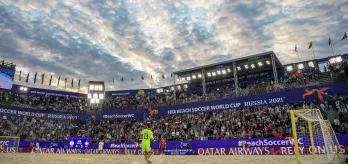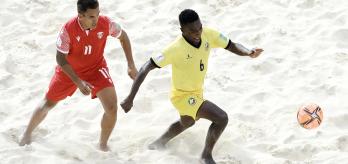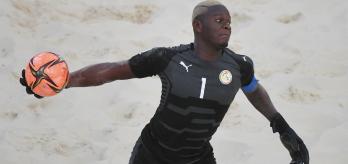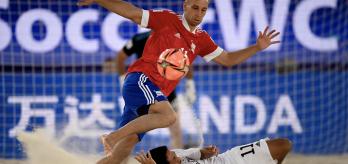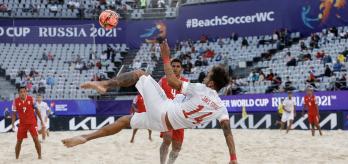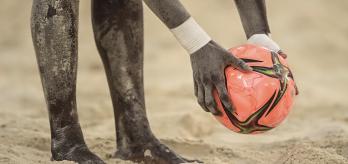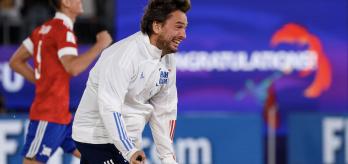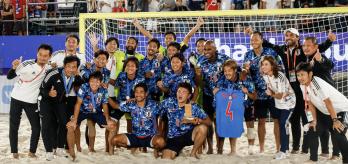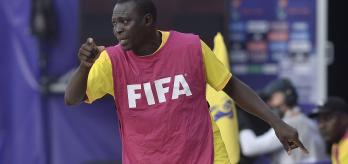An overview
In particular, the TSG decided to examine and analyse in a series of articles the approaches adopted by the 16 different participating national teams in their search for goals match after match.
The FIFA Beach Soccer World Cup Russia 2021™ breached the threshold of 300 goals for the first time: in 32 matches, a total of 302 goals were scored, with an average of 9.44 per match – the highest ever recorded, surpassing the previous record of 286 goals (8.94 goals per match) in the 2006 and 2019 editions.
Before going into detail, it needs to be emphasised that the tournament marked a very important moment in the evolution of the sport. The tournament was characterised by two key factors that had a significant influence in comparison with all previous editions:
- The first arises from the obstacles imposed by COVID-19 restrictions, which meant that many national teams were unable to prepare as they would have liked for the qualifying campaigns (which were not even played in Asia and Oceania) and for the World Cup itself.
- The second factor, with a much more direct impact at a technical and tactical level, relates to the introduction of some new rules, which had not happened since FIFA Beach Soccer World Cup Portugal 2015 (a four-second limit was imposed on teams in possession in their own penalty area, goalkeepers in possession were prevented from re-entering their penalty area after leaving it, and there was virtually complete protection for players executing overhead kicks).
The four-second limit and its impact
The latest step introduced this year prohibits goalkeepers from keeping the ball for more than four seconds inside their own half, which has had a drastic effect on the progress of the game, both in the possession phase and consequently, in the non-possession phase.
The pressure exerted on the goalkeeper by the ticking away of the seconds, especially in the typical situation of possession in a 2-2 formation (which in recent years has been by far the most common), where the goalkeeper plays with their feet, setting up moves from the back, has actually led to the disappearance of the defensive phase in a 2-1-1 system (the most common one at the FIFA Beach Soccer World Cup Paraguay 2019™). Once the goalkeeper left the area with the ball at their feet, the most common choice by far by opposition teams was to leave them free to play within the four-second limit, purely focusing on marking the remaining outfield players and not getting outnumbered. Only in a few situations was there comprehensive and organised pressure on a goalkeeper in possession of the ball.
Goalkeeper alone
Pressure on the goalkeeper
Consequently, during the possession phase, teams were forced to play forward much more often. Since the goalkeeper can no longer freely manage the ball during the construction phase (which simultaneously makes it more difficult to create overloads for either of the two wingers, who are almost always marked individually), coaches relied much more frequently on direct attacks, making particular use of throws by their goalkeepers.
Some teams even ended up changing their usual style of play that had characterised them and made them recognisable in previous years. This resulted in substantial changes to the rhythm and speed of the game and to the physical effort required of individual outfield players, who, in turn, are forced to make a more regular contribution to attacking moves, and also to make more frequent attacking and defensive transitions.
The statistics
On a statistical level, it is no coincidence that – in addition to an increase in the total goals scored, as mentioned earlier –a large number of goals were scored in both direct attack and counter-attack situations: the greater difficulty in creating overloads, which was previously obtained more easily with the goalkeepers playing with their feet in 2-2, obliged the players to try for more 1v1 individual attacks, while at the same time favouring duels won in the defensive phase and therefore producing an increase in counter-attacks.
A prime example of this was Spain 12-8 Tahiti, where the nine goals scored from open play all stemmed from direct attacks and counter-attacks.
In total, out of 175 goals scored from open play, 108 (61.7%) were scored as a result of counter-attacks (55) and direct attacks (53). Of the remaining 38.3% of goals from open play, 25 were scored from individual attacks and 41 from combination attacks (one was an own goal for which the defending team was directly and solely responsible).
The pivotal importance of goals scored from set plays (127 out of a total of 302, or 42.1%) was confirmed, further underlining the trend seen in recent editions.
Kick-offs, corners, attacking throw-ins, free kicks and penalties were once again the strong suit, with peaks in some games of 70% and above of the total goals scored. For example, in Switzerland v. Brazil, one of the finest matches of the entire tournament, seven goals out of ten came from set balls, while in the Russia v. Japan final, 71.4% of the goals (5 out of 7) were a direct result of set plays.
Finally, 68.9% of goals were scored as a result of zero to one passes, while 31.1% came at the end of moves involving two or more passes, confirming here too the data from the 2019 edition. Victory went to the team with the best defence at the tournament. Hosts Russia won the third World Cup in their history after conceding 18 goals in six matches (three goals per match). The team with the highest average number of goals scored (7.33 per match), giving it the best attack, was Switzerland with 44 goals in six matches.
Noteworthy firsts
Beyond the numbers, it should be noted that for the first time, neither Brazil nor Portugal were among the four semi-finalists: at least one of the two had always reached the semi-finals in all previous editions of the FIFA Beach Soccer World Cup. This was also the first time that the reigning champions, in this case Portugal, did not make it beyond the group stage.
Other firsts included the appearance of an African representative among the semi-finalists (










